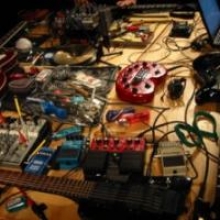
Tune in to Live Constructions this Sunday, June 28th, at 10PM to hear a live set by an electroacoustic trio composed of Hans Tammen, Erhard Hirt, and Michael Lyttle. Tammen (electronics), Erhard (prepared guitar and electronics) and Lyttle (clarinet) use a set up of acoustic instruments and electronic gadgets to create sprawling improvised pieces, creating an eclectic combination of different timbres. The trio came into our studio last week to play a 40 minute improvisation, and then they spoke to us about their music and history playing together. Listen!
Artist Bios:
Hans Tammen creates sounds that have been described as an alien world of bizarre textures and a journey through the land of unending sonic operations. He creates rapid-fire juxtapositions of radically contrastive and fascinating noises, with micropolyphonic timbres and textures, aggressive sonic eruptions, but also quiet pulses and barely audible sounds.
Erhard Hirt started playing blues guitar when he was 16 and for the next ten years played with jazz-oriented groups, experimental rock bands, a free jazz combo (Jazzcomunity, in Leverkusen/ Köln), and toured with blues bands (Delta Blues Band and the Matt Walsh Bluesband). In 1978 he performed his first improvised solo concerts, following this with his own group including players such as Martin Theurer, Hans Schneider, Thorsten Müller, Pinguin Moschner, and Wolfgang Fuchs. In 1980 he organised the first Workshop Freie Musik in Münster.
In 1981 Hirt formed the String Quintet with Anne Le Baron (harp), Candice Natvig (violin), Thorsten Müller (cello) and Hans Schneider (bass) and the following year recorded his first solo guitar record as well as working in and recording with the Quartet, XPact: Wolfgang Fuchs, Hans Schneider and Paul Lytton, and a trio with Radu Malfatti and Schneider. He founded the King Übü Orchestrü in 1984 along with Wolfgang Fuchs, March Charig, Guido Mazzon, Radu Malfatti, Phil Wachsmann, Alfred Zimmerlin, and others, and performed in a trio with Phil Minton and Willi Kellers.
Hirt has appeared at most of the usual free music and jazz festivals - Moers, the Total Music Meeting in Berlin, Musique Action in Vandoeuvre, Free Music in Antwerp - as well as some less common ones, in particular being a regular performer at the Humannoise Congress based in Wiesbaden since 1987. He has also organised a series of 'Guitar Projects' featuring, Guitar Project I (1987): Derek Bailey, Stephan Witwer and Burkhart Rogalla; Guitar Project II (1988): Davey Williams, John Russel, Uwe Kropinski and Joe Sachse; Guitar Project III (1989): Mike Cooper, Kalle Laar, and Lothar Fiedler; Guitar Project IV (1990): Eugene Chadbourne, Valery Dudkin and Reinbert Evers; Guitar Project V (1992): Hans Reichel, Jean Marc Montera and Frank Rühl; Guitar Project VI (1993): Dave Draper, Michael Kolberg and Udo Herbst.
In addition to the above groupings, he has played in duo with Lol Coxhill (1987) [and also in 1991 at Jazzfestival Münster], a trio with Phil Minton and Roger Turner (1986) and, since 1991, has been playing in a trio with Phil Minton and John Butcher. Since 1994 he has been involved with 'Film Projects' with Martin Cihak and Martin Klapper and Martin Theurer. In November 1995 he substituted for Derek Bailey during the Company performances in Vancouver, Canada. He visited the UK briefly in 1996 to play at the LMC's Fifth Festival of Experimental Music and to play a concert in Sheffield.
Michael Lytle's experience with electronic music lead him to lots of experiments with the clarinets. Being a stopped pipe (like a church organ) and a “cylindrical bore”, the clarinet has a different overtone system than most wind instruments, they being based on the “conical bore”, oddly, even the flute. So an interesting overtone system (the first overtone is an octave and a 5th) is at play as well as a large pitch range. As far as we know, Michael is the first player to explore the clarinet in this way. Both of them use the singing and playing technique, which produces a cord effect like an electronic ring modulator. And in “Dead Heat”, they explored “sum and difference” tones.
